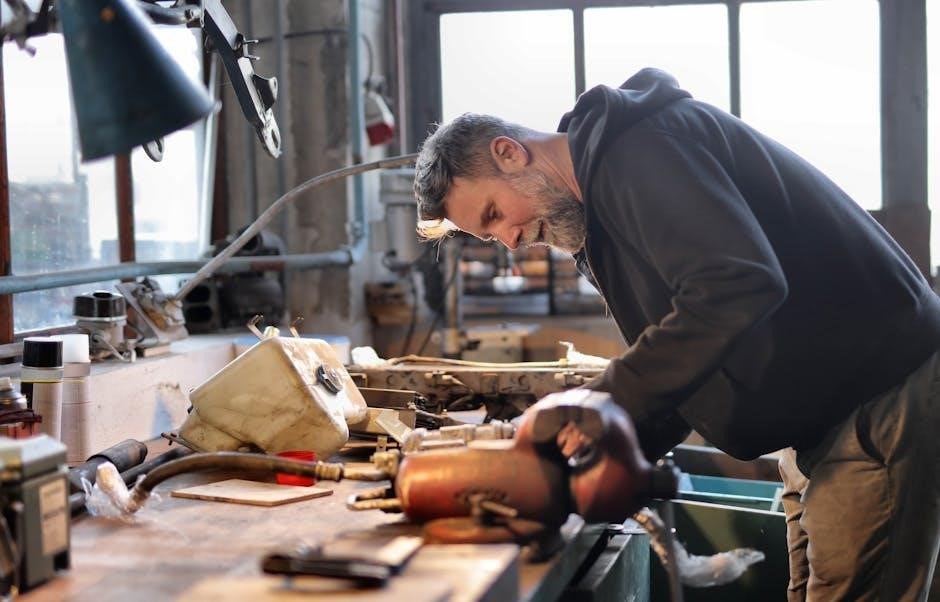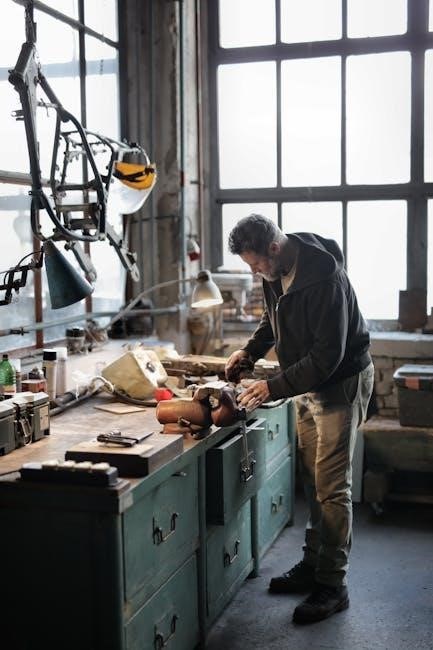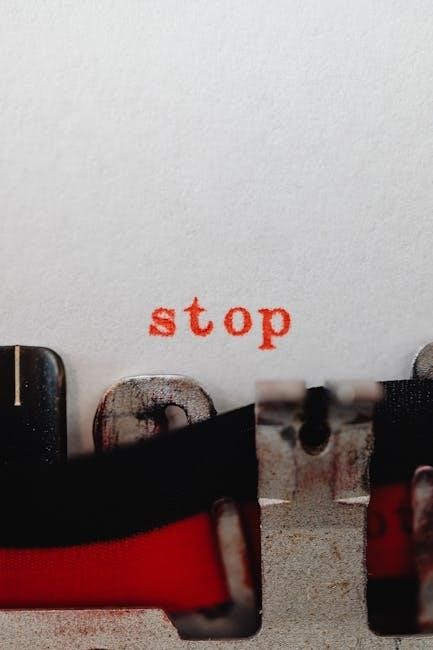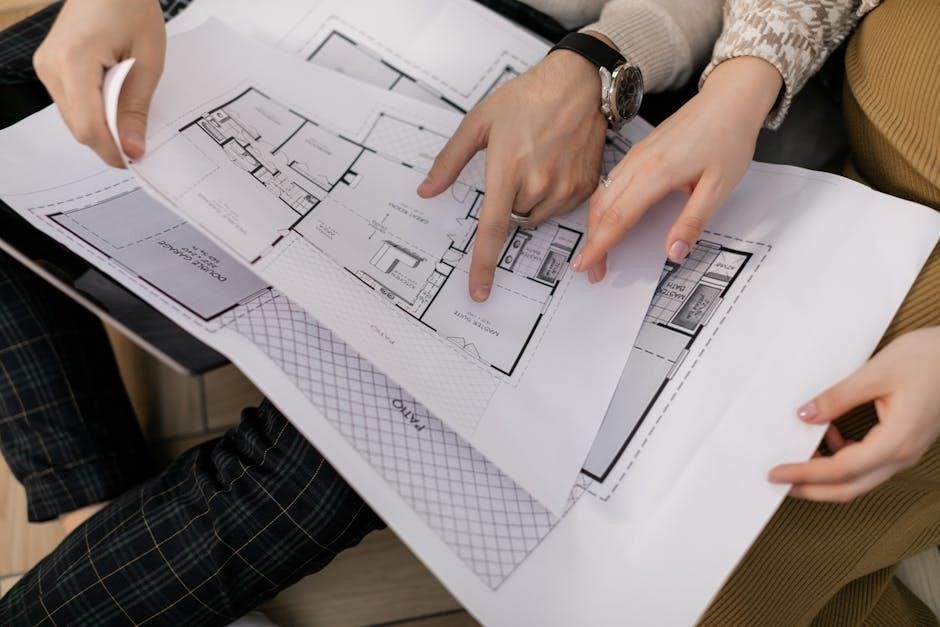Safety Precautions
Always read the manual before use and follow all instructions. Ensure proper installation and setup to avoid hazards. Keep the grill on a stable, heat-resistant surface, away from flammable materials. Never leave cooking unattended. Regularly inspect gas connections and lines for leaks. Store propane tanks upright and secure in a well-ventilated area. Keep children and pets away from the grill while in operation. In case of an emergency, turn off the gas supply immediately and use a fire extinguisher. Never use water to extinguish grease fires. Proper ventilation is essential to prevent carbon monoxide buildup. Always follow local fire safety regulations and guidelines.
- Ensure grill is placed on a level, heat-resistant surface.
- Keep flammable materials at least 10 feet away.
- Check for gas leaks before each use.
- Store propane tanks securely and upright.
- Never operate the grill in enclosed spaces.
1.1. Safe Installation and Setup
Ensure the grill is placed on a level, heat-resistant surface, away from flammable materials. Follow the manual’s assembly instructions carefully. Check all connections, especially gas lines, for leaks using a soapy water solution. Tighten any loose fittings and ensure the propane tank is securely attached. Position the grill in a well-ventilated area, avoiding enclosed spaces to prevent carbon monoxide buildup. Keep the grill at least 10 feet away from buildings, trees, and overhead structures. Never install the grill near open flames or sparks. After setup, perform a final safety check, ensuring all components are properly secured and functioning correctly. Refer to the manual for specific installation requirements and safety guidelines.
1.2. Handling Gas and Propane Safely
Always handle propane tanks and gas connections with care to prevent accidents. Store propane tanks upright in a well-ventilated area, away from heat sources and open flames. Before connecting the tank, ensure the valve is turned off. Use a soapy water solution to check for gas leaks around connections and hoses. If bubbles form, tighten the fitting or replace the seal. Never use an open flame to detect leaks. Keep the grill and propane tank away from children and pets. If you smell gas, turn off the supply immediately and ventilate the area. Follow the manual’s guidelines for proper gas line installation and maintenance to ensure safe operation.
- Store propane tanks upright and secure.
- Check for leaks with soapy water, not open flames.
- Keep the grill and tank away from heat sources.
- Turn off the tank valve when not in use.
1.3. Emergency Shutdown Procedures
In case of an emergency, stay calm and follow these steps to safely shut down your Nexgrill. First, immediately turn off the gas supply by closing the tank valve. If the grill is connected to a gas line, shut off the main supply valve. Next, turn all burner knobs to the “off” position to stop the flow of gas. If a fire occurs, do not use water; instead, use a fire extinguisher rated for grease and gas fires. Evacuate the area and ventilate it thoroughly if you smell gas or suspect a leak. For severe incidents, contact emergency services and avoid re-entering the area until it is deemed safe. Always refer to your manual for specific shutdown instructions tailored to your grill model.
- Turn off the gas supply at the tank or main valve.
- Close all burner knobs to stop gas flow.
- Use a fire extinguisher if a fire occurs.
- Evacuate and ventilate the area if gas is detected.
- Contact emergency services if necessary.

Assembly and Setup
Begin by unpacking and inventorying all parts. Follow the step-by-step instructions for assembling the grill. Tighten all bolts and connections securely. Connect gas lines properly and test for leaks. Ensure the grill is placed on a stable, level surface. Refer to the manual for specific assembly details tailored to your model.
- Unpack and organize all components carefully.
- Assemble according to the provided instructions.
- Ensure all connections are secure and leak-free.
- Position the grill on a stable, level surface.
2.1. Unpacking and Inventory of Parts
Start by carefully unpacking all components from the box. Lay out each part on a flat surface to ensure nothing is damaged or missing. Refer to the parts list in the manual to verify the contents. Check for any signs of damage during shipping and contact customer service if issues arise. Organize smaller parts like screws and bolts in a container to prevent loss. Once everything is accounted for, proceed with the assembly process. Proper organization ensures a smooth setup experience and helps avoid delays. Make sure all items are present before starting assembly to prevent setbacks.
- Inspect all parts for damage upon unpacking.
- Compare the contents with the manual’s parts list.
- Organize small components securely.
- Contact support if any items are missing or damaged.
- Ensure all parts are ready before assembly begins.
2.2. Step-by-Step Assembly Instructions
Begin by assembling the grill’s frame using the provided hardware. Attach the legs securely, ensuring stability. Next, install the cooking grates and heat deflectors according to the manual’s guidance. Connect the burners and ensure proper alignment with the igniter. Follow the instructions for attaching the shelves and any additional accessories. Tighten all bolts and screws firmly to ensure structural integrity. Refer to the diagrams in the manual for precise alignment. Once the main structure is complete, connect the propane tank and test for leaks. Double-check all connections before proceeding to the initial setup and testing phase. Proper assembly is crucial for safe and efficient operation.
- Assemble the frame and attach legs for stability.
- Install grates and deflectors as per manual instructions.
- Align and secure burners and ignition components.
- Attach shelves and accessories tightly.
- Ensure all connections are leak-free before use.

2.3. Initial Setup and Testing
After assembling the grill, connect the propane tank and ensure all connections are secure. Perform a leak test by applying a soapy water solution to the hoses and connections—bubbles indicate a leak. Preheat the grill to the highest temperature for 15-20 minutes to burn off any residues. Test the ignition system by lighting each burner individually to ensure proper function. Verify that all burners heat evenly and adjust as needed. Check the temperature gauge for accuracy and Familiarize yourself with the control knobs and their sensitivity. Once everything functions correctly, the grill is ready for its first use. Always follow the manual’s specific testing procedures to ensure safety and performance.
- Connect the propane tank securely and test for leaks.
- Preheat the grill to burn off manufacturing residues.
- Test the ignition and burner functionality.
- Ensure even heating and accurate temperature readings.
- Follow manual guidelines for initial testing.

Operating the Grill
Preheat the grill to desired temperature before cooking. Use the burner knobs to control heat levels. Ensure food is evenly placed for consistent cooking. Avoid flare-ups by managing grease and food debris. Clean grates before and after use with a wire brush. Keep the lid closed for even heat distribution. Monitor cooking times and temperatures for optimal results. Always use grill-safe utensils and follow recommended cooking practices for best outcomes.
- Preheat the grill thoroughly before cooking.
- Adjust burners to maintain desired temperatures.
- Prevent flare-ups by managing grease effectively.
- Clean grates regularly for optimal performance.
- Monitor cooking times and temperatures closely.
3.1. Lighting the Grill for the First Time
Before lighting the grill, ensure the propane tank is securely connected and the valve is open. Turn the burner knob to the “light” position and press the igniter button until a clicking sound is heard. If the igniter fails, light the burner manually with a long match or lighter. Always keep the lid open during the initial lighting to ensure proper airflow and avoid gas buildup. Once lit, adjust the burners to your desired temperature and allow the grill to preheat for 10-15 minutes. If you notice a low flame or uneven ignition, check for blockages in the burners or jets. Ensure the grill is on a stable, level surface before use.
- Connect the propane tank securely and open the valve.
- Turn the burner knob to the “light” position and press the igniter.
- Keep the lid open during initial lighting to prevent gas buildup.
- Preheat the grill for 10-15 minutes before cooking.
- Check for blockages if the flame is low or uneven.
3.2. Understanding Temperature Control
Mastering temperature control is essential for achieving perfectly cooked meals. Preheat the grill by turning all burners to high and closing the lid for 10-15 minutes. Use the built-in thermometer to monitor the temperature, adjusting burner knobs as needed. For indirect cooking, turn off select burners to create heat zones. Ensure proper airflow by keeping the vents open to maintain consistent heat. Avoid overheating by gradually adjusting the burners. If the grill heats unevenly, rotate food for even cooking. Regularly clean burners to ensure accurate temperature regulation. Always refer to the manual for specific temperature ranges and cooking guidelines for your Nexgrill model.
- Preheat the grill with all burners on high for 10-15 minutes.
- Use the thermometer to monitor and adjust heat levels.
- Create heat zones for indirect cooking by turning off select burners.
- Ensure proper airflow by keeping vents open.
- Rotate food if heat distribution is uneven.
3.3. Cooking Techniques and Best Practices
Optimize your grilling experience by mastering essential techniques. Preheat the grill to ensure even heat distribution. For direct cooking, place food over lit burners, while indirect cooking involves placing food away from direct flames. Use the grill’s temperature controls to achieve the perfect sear or slow-cooked finish. Always oil the grates before cooking to prevent sticking. Flip food gently to maintain juices and avoid pressing down on burgers, as this can squeeze out moisture. Use a food thermometer to ensure meats reach safe internal temperatures. Experiment with wood chips or pellets for added smoky flavor. Clean the grates after each use to maintain hygiene and prevent residue buildup. Follow these practices for consistent, delicious results every time.
- Preheat the grill to ensure even heat distribution.
- Use direct and indirect cooking methods for versatility.
- Oil grates before cooking to prevent sticking.
- Avoid pressing down on burgers to retain juices.
- Use a food thermometer for precise cooking temperatures.
- Experiment with wood chips for smoky flavor.
- Clean grates regularly for optimal performance.

Maintenance and Care
Regularly clean the grill grates and burners to maintain performance. Inspect gas lines for leaks and ensure tight connections. Store the grill in a dry, protected area during off-seasons to prevent rust. Lubricate moving parts annually and replace worn-out components promptly. Always follow the manufacturer’s recommendations for cleaning products and maintenance schedules to extend the grill’s lifespan.
- Clean grates after each use to prevent food residue buildup.
- Inspect and clean burners to ensure proper gas flow.
- Check gas lines for leaks using a soap solution.
- Store the grill securely to protect it from harsh weather.
- Replace worn-out parts to maintain optimal performance.
4.1. Cleaning the Grill and Grates
Regular cleaning is essential for maintaining your Nexgrill’s performance and longevity. Start by brushing the grates with a wire brush while they are still warm to remove food residue. Avoid using abrasive cleaners, as they may damage the grates. For tougher stains, mix baking soda and water to create a paste, apply it to the grates, and let it sit before scrubbing. Clean the burners and drip trays with a soft-bristle brush to prevent clogging. After cleaning, wipe down the exterior with a mild detergent and dry thoroughly to prevent rust. Regular deep cleaning of the grill interior and grates ensures optimal cooking results and prevents flare-ups.
- Brush grates while warm to remove food particles.
- Use a soft-bristle brush for burners and drip trays.
- Avoid harsh chemicals to prevent damage.
- Deep clean the grill interior periodically.
- Wipe the exterior with mild detergent and dry thoroughly.
4.2. Caring for Burners and Ignition Systems
Regular maintenance of burners and ignition systems ensures reliable performance and extends the grill’s lifespan. Inspect burners for blockages and clean them with a soft-bristle brush to remove debris. Use a small pin or toothpick to clear clogged burner ports. For the ignition system, ensure the battery is installed correctly and connections are secure. If the igniter fails, check for loose wires or dirt buildup and clean as needed. Avoid using harsh chemicals, as they may damage components. Lubricate burner valves periodically to maintain smooth operation. If issues persist, consult the manual or contact customer support for assistance. Proper care prevents gas leaks and ensures consistent ignition.

- Clean burners with a soft-bristle brush to remove debris.
- Clear clogged ports with a small pin or toothpick.
- Check ignition battery and connections regularly.
- Avoid harsh chemicals to prevent damage.
- Lubricate burner valves for smooth operation.
4.3. Regular Maintenance Schedule
Adhere to a maintenance schedule to keep your Nexgrill in optimal condition; After each use, clean the grates and burners to prevent food residue buildup. Weekly, inspect gas lines for leaks using a soap solution and wipe down surfaces. Monthly, clean the drip tray and grease pan thoroughly. Every 3 months, inspect and clean the venturi tubes and ignition electrodes. Annually, perform a deep clean of the grill interior and check for rust or damage. Lubricate moving parts like burner knobs and hinges. Replace worn-out parts promptly. Always refer to the manual for specific maintenance recommendations tailored to your grill model. Regular upkeep ensures safety, efficiency, and longevity.
- Clean grates and burners after each use.
- Inspect gas lines weekly with soap solution.
- Monthly clean drip tray and grease pan.
- Every 3 months, clean venturi tubes and ignition.
- Annual deep clean and rust inspection.
- Lubricate moving parts regularly.

Troubleshooting Common Issues
Address common issues promptly to ensure your grill operates smoothly. Check for igniter malfunctions, uneven heating, or gas leaks. Refer to the manual for detailed solutions or contact customer support for assistance.
- Igniter not clicking or producing flame.
- Uneven heat distribution or low flames.
- Gas leaks detected during operation.
5.1; Igniter Not Working
If the igniter fails to produce a spark or click, ensure the battery is installed correctly and replace it if necessary. Check the battery compartment for corrosion or damage. Verify that all grill parts are properly assembled, as missing components can prevent ignition. Ensure the gas tank is full and the valve is fully open. If issues persist, clean the igniter and surrounding area to remove debris. Test the igniter repeatedly to ensure proper function. If the problem remains unresolved, contact Nexgrill customer support for assistance or replacement parts.
- Replace the battery if it’s weak or corroded.
- Check for proper gas flow and connection.
- Clean the igniter and surrounding components.
- Use a spark tester to verify igniter functionality.
5.2. Uneven Heating or Low Flame
Uneven heating or low flame issues can often be resolved by checking the burner ports for blockages. Clean the ports using a small brush or toothbrush to remove food debris or dirt. Ensure the gas regulator is properly connected and functioning correctly. If the flame is low, verify that the gas tank is not empty and the valve is fully open. Adjusting the air shutter to the recommended setting can also improve flame consistency. If the issue persists, inspect the propane hose for kinks or damage and ensure all connections are secure. Refer to the manual for specific guidance or contact Nexgrill support for further assistance.
- Clean burner ports to ensure proper gas flow.
- Check the gas regulator and propane tank level.
- Adjust the air shutter for optimal flame height.
- Inspect the propane hose for kinks or damage.
5.3. Gas Leak Detection and Prevention
Regularly inspect gas lines and connections for signs of wear, damage, or corrosion. Use a soapy water solution to check for leaks: apply it to the hoses and connections, and look for bubbles forming. If bubbles appear, tighten the connections or replace the damaged parts. Always turn off the gas supply when not in use. If you suspect a gas leak, immediately turn off the gas supply and ventilate the area. Never use an open flame to detect leaks. Ensure all connections are secure and follow the manufacturer’s guidelines for proper setup. Annual professional inspections are recommended to maintain safety and prevent potential hazards.
- Inspect gas lines and connections regularly for damage.
- Use a soapy water solution to detect leaks.
- Tighten or replace parts if leaks are found.
- Turn off the gas supply when not in use.
- Ventilate the area if a leak is suspected.

Modifications and Accessories
Enhance your grilling experience with compatible accessories like grill covers, rotisserie kits, and grilling tools. Consider upgrading burners or grates for improved performance and durability. Always consult the manual before making modifications to ensure compatibility and safety. Nexgrill-approved products are recommended for optimal results and warranty preservation.
- Use Nexgrill-approved accessories for compatibility.
- Upgrade burners or grates for enhanced performance.
- Consult the manual before making modifications;
6.1. Upgrading Grill Parts for Better Performance
Upgrading your Nexgrill parts can significantly enhance its performance. Consider replacing the burners with high-quality stainless steel or infrared burners for consistent heat distribution. Grates can be upgraded to cast iron or porcelain-coated options for better searing and durability. Ignition systems can be improved with electronic ignitions for reliable lighting. Additionally, installing a smoker box or rotisserie kit expands your cooking capabilities. Always ensure compatibility with your specific Nexgrill model and follow installation instructions carefully to maintain safety and warranty. Upgrades should be done by experienced users or professionals to avoid any potential risks or voiding the warranty.
- Upgrade burners for consistent heat distribution.
- Replace grates with durable, high-quality options.
- Enhance ignition systems for reliable performance.
- Add accessories like smoker boxes or rotisserie kits.
- Ensure all upgrades are compatible with your model.
- Follow installation instructions to maintain safety.
6.2. Compatible Accessories for Enhanced Grilling
Enhance your grilling experience with compatible accessories designed for your Nexgrill. A grill cover protects your unit from weather damage and extends its lifespan. Rotisserie kits allow for even cooking of large meats, while smoker boxes add smoky flavors to your dishes. Grill mats prevent food from sticking and make cleanup easier. Temperature probes ensure precise monitoring of internal temperatures. Additionally, griddle plates can transform your grill into a flat-top cooking surface for pancakes, eggs, and seared vegetables. These accessories are designed to fit your Nexgrill model, ensuring compatibility and optimal performance. Always refer to your owner’s manual for recommended accessories and installation guidelines to maximize your grilling potential safely and effectively.
- Grill covers protect against weather damage.
- Rotisserie kits enable even cooking of large meats.
- Smoker boxes add smoky flavors to dishes.
- Grill mats prevent sticking and simplify cleanup.
- Temperature probes ensure precise temperature control.
- Griddle plates offer versatile cooking options.

Warranty and Support
For warranty information, contact Nexgrill customer service at 1-800-648-5864 or visit their official website. Refer to your manual for specific warranty details and support options.
7.1. Understanding Your Grill’s Warranty
Your Nexgrill warranty provides coverage for defects in materials and workmanship. The warranty period varies by component, with the main grill body typically covered for 5 years, burners for 5 years, and electronic parts for 1 year. To ensure coverage, register your grill on Nexgrill’s website within 30 days of purchase. Keep your proof of purchase handy, as it may be required for warranty claims. Refer to your manual for specific terms and conditions. Damage from misuse, improper assembly, or failure to maintain the grill may void the warranty. For warranty-related inquiries, contact Nexgrill customer service at 1-800-648-5864 or visit their official website.
- Main grill body: 5-year warranty
- Burners: 5-year warranty
- Electronic components: 1-year warranty
7.2. Contacting Nexgrill Customer Service
Nexgrill customer service is available to assist with any questions or concerns. You can reach them by calling 1-800-648-5864 or visiting their official website at nexgrill.com. For email inquiries, use the contact form provided on their website. When contacting, have your grill’s model number and proof of purchase ready for faster assistance. Representatives are trained to help with troubleshooting, warranty claims, and maintenance tips. For urgent issues, phone support is recommended. Regular business hours apply, so check their website for operating times. Nexgrill aims to provide timely and effective solutions to ensure your grilling experience remains enjoyable.
- Phone: 1-800-648-5864
- Website: nexgrill.com
- Email: Use the contact form on their website

User Reviews and Feedback
Customers praise the grill’s even cooking and quick heating. Many appreciate its compact design and easy assembly. Some note minor issues with igniter reliability over time.
- Even cooking performance
- Quick heating capabilities
- Compact and durable design
- Igniter issues reported by a few users
8.1. Common Praise and Positive Experiences
Users frequently highlight the Nexgrill’s consistent performance, with many praising its ability to cook evenly and heat up quickly. The durable construction and sleek design are also commended, making it a stylish addition to outdoor spaces. Several customers appreciate the easy assembly process, noting that the detailed instructions make setup straightforward. The grill’s compact size is another positive feature, allowing it to fit well in smaller yards without compromising cooking capacity. Many users also mention the excellent value for the price, stating that it offers high-quality grilling experiences comparable to more expensive models. Overall, the Nexgrill is often described as a reliable and efficient choice for both casual and experienced grillers.
- Even cooking and consistent heat distribution.
- Durable and stylish design.
- Easy assembly with clear instructions.
- Compact size for smaller spaces.
- Great value for the price.
8.2. Frequently Reported Issues and Solutions
Some users have reported issues with the igniter not working, which can often be resolved by replacing the battery or cleaning the ignition system. Others mention uneven heating or low flame, which may require adjusting the burner ports or ensuring proper gas flow. Gas leaks are another concern, typically detected by the smell of propane, and should be addressed by tightening connections or replacing faulty hoses. A few customers note that the grates may require occasional seasoning to prevent rust; For burner malfunctions, checking for blockages or debris is recommended. If issues persist, contacting Nexgrill customer service is advised for further assistance or potential repairs.
- Igniter issues: Replace battery or clean ignition system.
- Uneven heating: Adjust burner ports or ensure proper gas flow.
- Gas leaks: Tighten connections or replace hoses.
- Grate maintenance: Season regularly to prevent rust.
- Burner problems: Check for debris or blockages.
